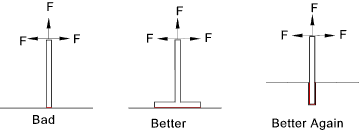| |
Adhesives
|
Introduction.. (Refer also to notes Adhesive theories ) An adhesive is a substance that fastens or bonds materials using surface attachment.
The strength of an adhesive joint depends on the strength of the attachment of the adhesive to
the material surface (substrate) termed adhesion and strength of the adhesive termed cohesion.
Adhesives can also provide a sealing function.
Theoretically an adhesive joint is the ideal joint for permanently /semi-permanently fastening components together. Limitations of adhesive joints are listed below.
Adhesive Joints When designing adhesives joint it is better the the operating load is transferred as
a shear stress as opposed to a tensile stress. Adhesives are also poor in
withstanding peel and cleavage loads. The most typical design of adhesive joints are the
lap joint and the axial fit joint. Normal adhesive joints are shown below. The double lap joint is preferred
to a single lap joint as bending moments are reduced and , as a result peel loads are reduced.
The sketches below indicate simple methods of providing improved adhesive joints be reducing the peel load.
Co-Axial joints /Screw Threads Co-axial joints are generally associated with fitted bearings shafts, splines and press fitted
components either permanent or semi-permanent. The anaerobic adhesive is ideally suited for these
applications. They can be formulated such to withstand high shear loads for permanent assemblies or lower
shear loads for assemblies that need to be dismantled. Surface Preparation It is necessary to ensure that the substrate surfaces of the components being
attached are suitably prepared. For all adhesive joints the minimum surface
preparation is to clean the surfaces such that all loose substrate and grease is removed.
The surfaces to be joined should be flat, some adhesives are more capable of filling
spaces, but the flatter the surface the stronger the joint.
When using cyanoacrylate adhesives it is necessary to ensure that chlorinated solvents are not used for surface penetration.
These solvents have acid stabilisers which prevent curing of the particular solvent. Different Types of adhesive Note: Selecting adhesives from the linked information below. Generally set by solvent evaporation. They are generally of low strength and are
susceptible to moisture and mould. Their use is restricted to the joining of low strength
materials. Natural adhesives include animal glues, fish glues, vegetable glues and casein.
Based on natural and synthetic rubbers set by solvent evaporation or heat curing. They have relatively low shear strength and suffer from creep and are therefore used for unstressed joints. They are useful for flexible bonds with plastics and rubbers. �Contact adhesives� use rubber in a solvent and will join many materials. Elastomer adhesives include natural rubbers, polychloroprenes (neoprene), acrylonitride butadiene (nitrile), butyl rubber adhesives, styrene butadiene rubber adhesives, polyurethane adhesives, polysulphide rubber adhesives and silicone rubber adhesives. Thermoplastic Adhesives...Themoplastic Adhesives In general, thermoplastic adhesives have low/medium shear strength and may suffer from
creep at high loading. They have good resistance to oils but poor resistance to
water. Thermoplastic adhesives include polyvinyl acetate (PVA), polyvinyl alcohol (PVA),
polyacrylates, polyester acrylics, acrylic solvent cement, cyanoacrylates (superglue), silicone
resins, polyamides and acrylic acid diesters. Thermoset adhesives set as a result of the build up of molecular chains to produce a rigid crosslinked
structure. They include epoxy resins, which are some of the most widely used
adhesives. There are many different thermoset adhesives available including phenolic
formaldehyde (PF) resins, phenolic neoprene, resorcinol formaldehydes (RF), polyesters,
polyimides and epoxy resins. During the last 25 years a process known as 'toughening' has been developed.
A toughened adhesive has small, rubber-like particles dispersed throughout the
glassy matrix. The profound effect of these particles is to change
the mechanical characteristics of the adhesive making it much more resistant to
crack propagation. This technology has only been successfully
applied to the acrylic and epoxy-based adhesives. Shear and Peel Strengths of Generic Adhesive types Important Note: The values below are random values obtained from general reference sources
and suppliers catalogues. They are often rounded values from imperial. They are only of
use to indicate the relative strengths of different adhesives. Links are provided below
with much better quality information. Always consult manufacturers literature
when selecting and designing with adhesives
| |||||||||||||||||||||||||||||||||||||||||||||||||||||||||||||||||||||||||||||||||||||
Sites Providing Relevant Information
|
|


